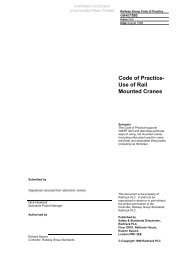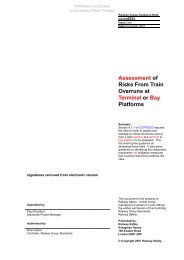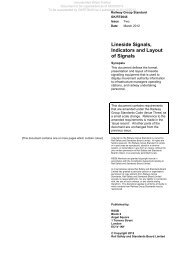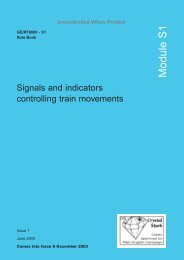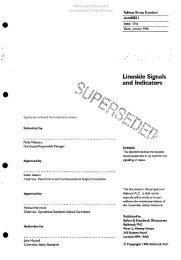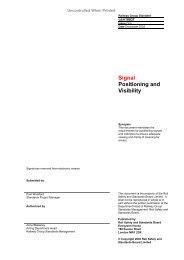General Information on Track Circuits - RGS Online
General Information on Track Circuits - RGS Online
General Information on Track Circuits - RGS Online
Create successful ePaper yourself
Turn your PDF publications into a flip-book with our unique Google optimized e-Paper software.
Railway Group Approved Code of Practice<br />
GK/RC0752<br />
Issue Two<br />
Date December 1998<br />
Page F4 of 5<br />
5 <strong>Track</strong> Circuit Fault<br />
Detector<br />
Withdrawn Document<br />
Unc<strong>on</strong>trolled When Printed<br />
<str<strong>on</strong>g>General</str<strong>on</strong>g> <str<strong>on</strong>g>Informati<strong>on</strong></str<strong>on</strong>g> <strong>on</strong> <strong>Track</strong> <strong>Circuits</strong><br />
The clip assembly should then be plainly marked for attenti<strong>on</strong> by the Permanent<br />
Way Engineer.<br />
The brush carriers can be raised/lowered to cater for flat or Pandrol type rail<br />
clips by moving the brush carrier handle to its vertical positi<strong>on</strong> to release the<br />
locking mechanism.<br />
Care must be taken to ensure that the rollers of the unit do not straddle any<br />
IRJs, causing “flicking” of adjacent track circuits.<br />
Short circuits between the rails can be difficult to locate, since, except for audio<br />
frequency types, the short circuit results in an identical drop in rail voltage al<strong>on</strong>g<br />
the length of the track circuit and gives no clue as to its physical locati<strong>on</strong>.<br />
Without the <strong>Track</strong> Circuit Fault Detector, it would often be necessary to sub–<br />
divide the trackwork to locate the faulty secti<strong>on</strong>.<br />
The detector is designed to be used <strong>on</strong> the trackwork of a track circuit where the<br />
feed and relay have been disc<strong>on</strong>nected. It c<strong>on</strong>sists of two portable battery<br />
powered units: a transmitter and a receiver.<br />
Transmitter This is housed in a box incorporating an “<strong>on</strong>/off” switch and an LED<br />
indicati<strong>on</strong>. Yellow leads with clips are provided to c<strong>on</strong>nect the unit<br />
across the rails or lineside apparatus housing links. It is battery<br />
powered and outputs an intermittent high frequency voltage.<br />
Receiver This is housed in a box incorporating an “<strong>on</strong>/off” switch and an LED<br />
indicati<strong>on</strong>. It is battery powered and incorporates an internal aerial,<br />
amplifier and loudspeaker. When the receiver detects a signal<br />
from the transmitter it outputs an audible t<strong>on</strong>e.<br />
Before commencing to test the b<strong>on</strong>ding of a track circuit, the track circuit fault<br />
detector should be checked as follows:<br />
a) The transmitter leads should be c<strong>on</strong>nected together and the transmitter<br />
switched <strong>on</strong>.<br />
b) The receiver should then be switched <strong>on</strong> and held near the transmitter leads;<br />
an audible t<strong>on</strong>e should be heard emitting from the receiver (this simple test<br />
will prove that the fault detector is working correctly).<br />
c) The feed and relay ends of the track circuit under test should be<br />
disc<strong>on</strong>nected. With jointless track circuits, the track circuits either side of the<br />
track circuit under test should also be shorted out.<br />
d) The transmitter should then be c<strong>on</strong>nected across the rails at the feed end<br />
and switched <strong>on</strong>. The receiver is switched <strong>on</strong> and held near the rail; an<br />
audible t<strong>on</strong>e should be heard emitting from the receiver. No t<strong>on</strong>e may<br />
indicate a bad c<strong>on</strong>necti<strong>on</strong> to the rails. If the rail c<strong>on</strong>necti<strong>on</strong>s are good, the<br />
fault is an open circuit, which may be found in the c<strong>on</strong>venti<strong>on</strong>al manner. If an<br />
audible t<strong>on</strong>e is heard, the receiver should then be carried al<strong>on</strong>g the track<br />
near to the rail and when the receiver passes the short circuit, a distinct drop<br />
in the volume of the t<strong>on</strong>e will be noted.<br />
F4 R A I L T R A C K



